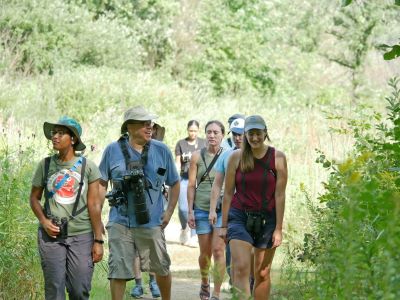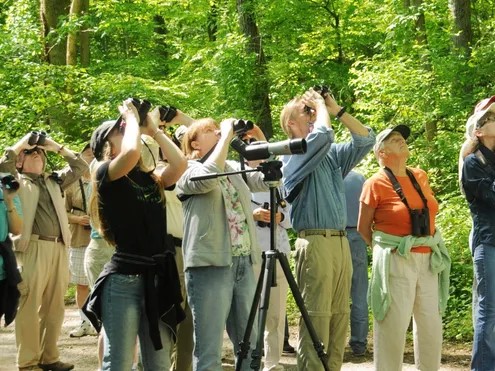Our First Saturday Bird Outings, created as part of our commitment to the Lane Audubon…
 A Cooper’s Hawk regularly visits the bird-feeder area on our property in the southwest hills of Eugene. The raised bird feeders are in a deer-fenced 20′ x 20′ space filled with plants and flowers and surrounded by trees. In our effort to provide suitable habitat for songbirds, we have attracted the resident predator of birds.
A Cooper’s Hawk regularly visits the bird-feeder area on our property in the southwest hills of Eugene. The raised bird feeders are in a deer-fenced 20′ x 20′ space filled with plants and flowers and surrounded by trees. In our effort to provide suitable habitat for songbirds, we have attracted the resident predator of birds.
During the winter, the Cooper’s Hawk often perches conspicuously in an oak tree about 100 feet away from the bird feeders until she decides it is time to hunt. Often we see her make quick-strike passes through the yard, scaring the smaller birds away and, unfortunately, sometimes flushing them into a window. We have seen the hawk catch birds in midair and pursue them around and through trees. She is a fast and agile hunter, making sharp turns and looping back around to continue her surprise attacks. After an unsuccessful foray, she sometimes sits on the fence around the bird feeders, giving us a great view from the kitchen window. Her alert eyes and quick glances show that she is watching for movement in the bushes below. We have seen the Cooper’s pounce to the ground and stomp her feet near the low bushes to flush the smaller birds hiding there.
The ground-hunting behavior is interesting to watch. We have seen the hawk dive into a bush and the small birds quickly exit through the other side. She may remain on the ground for several minutes, checking the bushes thoroughly. We know the Cooper’s hunts successfully this way because we’ve found evidence—feather piles that we’ve identified as Mourning Dove, Band-tailed Pigeon, Spotted Towhee, Dark-eyed Junco, Steller’s Jay, Varied Thrush, Western Bluebird, and swallow species (which we have seen caught on the wing).
The hawk does not catch a bird every time she tries. Sometimes she seems to take all day to catch a meal, based on the number of hunting forays we observe. The hawk lives on the edge of survival in the winter cold, and she certainly puts pressure on the songbirds. Usually the healthy songbirds can escape her attacks, and the predator’s presence keeps them fit and alert so they are better able to survive as well. The small birds resume their own eating and chasing once the Cooper’s Hawk leaves the immediate vicinity.
It is nature’s way. We love the songbirds and the hawks alike.



